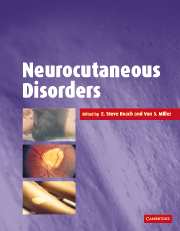Book contents
- Frontmatter
- Contents
- Contributors
- Foreword
- Preface
- 1 Introduction
- 2 Genetics of neurocutaneous disorders
- 3 Clinical recognition
- 4 Neurofibromatosis type 1
- 5 Neurofibromatosis type 2
- 6 Tuberous sclerosis complex
- 7 von Hippel–Lindau disease
- 8 Neurocutaneous melanosis
- 9 Nevoid basal cell carcinoma (Gorlin) syndrome
- 10 Epidermal nevus syndromes
- 11 Multiple endocrine neoplasia type 2
- 12 Ataxia–telangiectasia
- 13 Incontinentia pigmenti
- 14 Hypomelanosis of Ito
- 15 Cowden disease
- 16 Pseudoxanthoma elasticum
- 17 Ehlers–Danlos syndromes
- 18 Hutchinson–Gilford progeria syndrome
- 19 Blue rubber bleb nevus syndrome
- 20 Hereditary hemorrhagic telangiectasia (Osler–Weber–Rendu)
- 21 Hereditary neurocutaneous angiomatosis
- 22 Cutaneous hemangiomas: vascular anomaly complex
- 23 Sturge–Weber syndrome
- 24 Lesch–Nyhan syndrome
- 25 Multiple carboxylase deficiency
- 26 Homocystinuria due to cystathionine β-synthase (CBS) deficiency
- 27 Fucosidosis
- 28 Menkes disease
- 29 Xeroderma pigmentosum, Cockayne syndrome and trichothiodystrophy
- 30 Cerebrotendinous xanthomatosis
- 31 Adrenoleukodystrophy
- 32 Peroxisomal disorders
- 33 Familial dysautonomia
- 34 Fabry disease
- 35 Giant axonal neuropathy
- 36 Chediak–Higashi syndrome
- 37 Encephalocraniocutaneous lipomatosis
- 38 Cerebello-trigemino-dermal dysplasia
- 39 Coffin–Siris syndrome: clinical delineation; differential diagnosis and long-term evolution
- 40 Lipoid proteinosis
- 41 Macrodactyly–nerve fibrolipoma
- Index
- References
16 - Pseudoxanthoma elasticum
Published online by Cambridge University Press: 31 July 2009
- Frontmatter
- Contents
- Contributors
- Foreword
- Preface
- 1 Introduction
- 2 Genetics of neurocutaneous disorders
- 3 Clinical recognition
- 4 Neurofibromatosis type 1
- 5 Neurofibromatosis type 2
- 6 Tuberous sclerosis complex
- 7 von Hippel–Lindau disease
- 8 Neurocutaneous melanosis
- 9 Nevoid basal cell carcinoma (Gorlin) syndrome
- 10 Epidermal nevus syndromes
- 11 Multiple endocrine neoplasia type 2
- 12 Ataxia–telangiectasia
- 13 Incontinentia pigmenti
- 14 Hypomelanosis of Ito
- 15 Cowden disease
- 16 Pseudoxanthoma elasticum
- 17 Ehlers–Danlos syndromes
- 18 Hutchinson–Gilford progeria syndrome
- 19 Blue rubber bleb nevus syndrome
- 20 Hereditary hemorrhagic telangiectasia (Osler–Weber–Rendu)
- 21 Hereditary neurocutaneous angiomatosis
- 22 Cutaneous hemangiomas: vascular anomaly complex
- 23 Sturge–Weber syndrome
- 24 Lesch–Nyhan syndrome
- 25 Multiple carboxylase deficiency
- 26 Homocystinuria due to cystathionine β-synthase (CBS) deficiency
- 27 Fucosidosis
- 28 Menkes disease
- 29 Xeroderma pigmentosum, Cockayne syndrome and trichothiodystrophy
- 30 Cerebrotendinous xanthomatosis
- 31 Adrenoleukodystrophy
- 32 Peroxisomal disorders
- 33 Familial dysautonomia
- 34 Fabry disease
- 35 Giant axonal neuropathy
- 36 Chediak–Higashi syndrome
- 37 Encephalocraniocutaneous lipomatosis
- 38 Cerebello-trigemino-dermal dysplasia
- 39 Coffin–Siris syndrome: clinical delineation; differential diagnosis and long-term evolution
- 40 Lipoid proteinosis
- 41 Macrodactyly–nerve fibrolipoma
- Index
- References
Summary
Pseudoxanthoma elasticum (PXE) is a hereditary connective tissue disorder characterized by disintegration and calcification of elastic fibers. Abnormal elastic fibers in the skin, retina, and cardiovascular system produce characteristic manifestations in these areas. Life expectancy is not dramatically reduced. The prevalence of PXE is estimated to be about 1 in 75 000, but this may be a low estimate because many cases go undiagnosed.
History
The first clinical description of PXE was by Balzer in 1884, although he did not recognize the basic pathology of calcifying elastic fibers and proposed instead that the disorder was a xanthoma (Balzer, 1884). Balzer's patient and others were reviewed by Darier, who performed microscopic examinations of the skin lesions and found mineralization of the elastic fibers rather than the xanthoma suggested by Balzer. To stress the absence of a xanthomatous process, Darier in 1896 coined the term ‘pseudoxanthoma’ and added ‘elasticum’ to identify the anatomic site of the pathology (Darier, 1896).
It took another 40 years to complete the triad. Angioid streaks had been defined by Doyne (1889) and Knapp (1892) but were not associated with PXE. Grönblad (1929) and Strandberg (1929) first recognized the retinal complications as a feature of PXE, and, in 1944, Carlborg described the cardiovascular aspects of PXE, thus completing the triad. Pseudoxanthoma elasticum has remained the title of choice in the world literature, perhaps because the abbreviation PXE is easy to remember. The eponymic Grönblad–Strandberg syndrome is still occasionally used in Europe.
Information
- Type
- Chapter
- Information
- Neurocutaneous Disorders , pp. 138 - 143Publisher: Cambridge University PressPrint publication year: 2004
References
Accessibility standard: Unknown
Why this information is here
This section outlines the accessibility features of this content - including support for screen readers, full keyboard navigation and high-contrast display options. This may not be relevant for you.Accessibility Information
- 1
- Cited by
